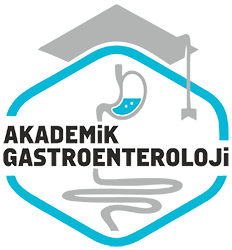Aralik 2014
Groove pankreatit; farkli klinik seyir gösteren iki olgu
Groove pancreatitis; two cases with different clinical course
- Ana Sayfa
- Sayılar
- Aralik 2014
- Groove pankreatit; farkli klinik seyir gösteren iki olgu
...
Özet
Groove pankreatit, groove alan olarak adlandirilan pankreas basi, duodenum ve koledok arasındaki anatomik bölgeyi etkileyen kronik segmental pankreatittir. Alkol ve sigara kullanım öyküsü olan genç erkek hastalarda sıklıkla görülmektedir. Bu yazida klinigimizde tanı koyarak izledigimiz farkli klinik tablo ile seyreden iki groove pankreatitli olgu sunmaktayiz. Birinci olgu; öyküsünde pankratit ataklari tanımlayan, karın ağrısı, bulanti, kusma şikayetleri olan ve üst gastrointestinal sistem endokopisinde duodenum 2. segmente geçiste darlik saptanan hastamizdi. Bu olguda pankreatiko-duodenektomi sonrasi semptomlarda belirgin iyılesme oldu. Ikinci olgumuzda ise karın ağrısı, kilo kaybı ve ikter şikayetleri mevcuttu. Radyolojik görüntülemede koledokta dilatasyon saptanmasi üzerine koledoga biliyer stent konularak hasta alkolsüz olarak 3 ay izlendi. 3 aylik takip sonucunda hem semptomatik iyılesme, hem de bilirübin seviyelerinde normalizasyon elde edildi. Daha sonrasinda biliyer stent çikarilarak izleme alındıginda 3 aylik periyotta klinik ve laboratuvar olarak nüks saptanmadi. Bu iki olguda olduğu gibi groove pankreatit tedavisi hastanın klinik ve tutulum yerinin farkliligina göre degismektedir. Alkol ve sigara kullanım öyküsü olan 40-50 yaş erkek hastalarda kronik pankreatitin bir formu olan groove pankreatit akilda tutulmalidir.
Abstract
Groove pancreatitis is a rare chronic segmental pancreatitis affecting the groove area of the pancreas (anatomical region between the head of the pancreas, duodenum, and common bile duct). It’s often seen in middle-aged males with histories of heavy alcohol and nicotine use. In this report, we present two cases of groove pancreatitis that were diagnosed and followed in our clinic, each with a different clinical course. In the first case, a patient presented with episodic pancreatitis, abdominal pain, nausea and vomiting. A diagnosis of stenosis in the transition from the first to second segment of the duodenum was made using upper gastrointestinal endoscopy. A significant improvement in symptoms occurred after the patient underwent a Whipple procedure (pancreaticoduodenectomy). In the second case, a patient complained of abdominal pain, weight loss and jaundice. Radiologic imaging showed dilatation of the common bile duct. A biliary stent was placed in the common bile duct and the patient was followed for three months; during this time, the patient refrained from alcohol use, bilirubin levels returned to normal and the patient remained asymptomatic. The biliary stent was then removed and no further clinical or laboratory recurrence was observed after the three-month period. These cases demonstrate that groove pancreatitis treatment varies according to a patient’s clinical indications and the location of involvement. Groove pancreatitis, a rare form of chronic pancreatitis, should be considered in male patients between the ages of 30 to 50 years old, who present with a history of heavy alcohol and cigarette use.



